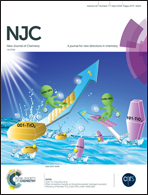Novel Cu2+-specific “Turn-ON” fluorescent probe based on [5]helicene with very large Stokes shift and its potential application in living cells†
Abstract
A novel fluorescent sensor based on a [5]helicene dye bearing hydrazine (1) was synthesized through a simple reaction. The sensor was fully characterized by NMR, single crystal X-ray analysis, and HRMS spectrometry. Fluorescence technique was also employed to study the ability of 1 for the detection of Cu2+ among different ions. It was found that 1 exhibited a highly sensitive fluorescence response toward Cu2+ with a “Turn-ON” fluorescence enhancement and a very large Stokes shift of ∼183 nm. The sensor selectively bound to Cu2+ in the presence of various metal ions, such as Cd2+, Ag+, Pb2+, Zn2+, Ni2+, Hg2+, K+, Li+, Ba2+, Al3+, Fe2+, Co2+, Mn2+, Ca2+, Na+, and Mg2+ in aqueous acetonitrile solution. The Cu2+ detection limit was 2.6 ppb (3σ/slope), which was lower than the permissible concentration in drinking water determined by the US EPA and WHO. In addition, the sensor can enhance fluorescence from the intracellular area in the HepG2 cellular system. Hence, it has the potential for the detection of Cu2+ in biological samples.
![Graphical abstract: Novel Cu2+-specific “Turn-ON” fluorescent probe based on [5]helicene with very large Stokes shift and its potential application in living cells](/en/Image/Get?imageInfo.ImageType=GA&imageInfo.ImageIdentifier.ManuscriptID=C7NJ05176J&imageInfo.ImageIdentifier.Year=2018)


 Please wait while we load your content...
Please wait while we load your content...